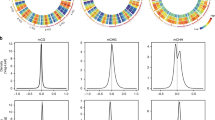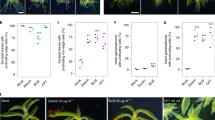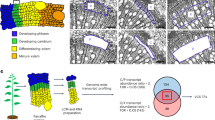Abstract
Epigenetic modifications, including histone modifications, stabilize cell-specific gene expression programmes to maintain cell identities in both metazoans and land plants1,2,3. Notwithstanding the existence of these stable cell states, in land plants, stem cells are formed from differentiated cells during post-embryonic development and regeneration4,5,6, indicating that land plants have an intrinsic ability to regulate epigenetic memory to initiate a new gene regulatory network. However, it is less well understood how epigenetic modifications are locally regulated to influence the specific genes necessary for cellular changes without affecting other genes in a genome. In this study, we found that ectopic induction of the AP2/ERF transcription factor STEMIN1 in leaf cells of the moss Physcomitrella patens decreases a repressive chromatin mark, histone H3 lysine 27 trimethylation (H3K27me3), on its direct target genes before cell division, resulting in the conversion of leaf cells to chloronema apical stem cells. STEMIN1 and its homologues positively regulate the formation of secondary chloronema apical stem cells from chloronema cells during development. Our results suggest that STEMIN1 functions within an intrinsic mechanism underlying local H3K27me3 reprogramming to initiate stem cell formation.
This is a preview of subscription content, access via your institution
Access options
Access Nature and 54 other Nature Portfolio journals
Get Nature+, our best-value online-access subscription
$29.99 / 30 days
cancel any time
Subscribe to this journal
Receive 12 digital issues and online access to articles
$119.00 per year
only $9.92 per issue
Buy this article
- Purchase on Springer Link
- Instant access to full article PDF
Prices may be subject to local taxes which are calculated during checkout




Similar content being viewed by others
Data availability
Sequence data for genes and plasmids discussed in this article can be found in DDBJ/GenBank/EMBL data libraries under the following accession numbers: STEMIN1 (Pp3c1_27440: LC042086), STEMIN2 (Pp3c14_9940: LC042087), STEMIN3 (Pp3c10_7030: LC042088), pLGZ1 (AB602442), pGX6M (LC388570), pT2GX6 (LC388571), pPIG1bNGGII (AB537478), p35S-loxP-BSD (AB537973), p35S-loxP-Zeo (AB540628) and pTN182 (AB267706). The ChIP-seq and RNA-seq data for identification of STEMIN1-target genes and the ChIP-seq data for histone modifications are deposited in the DDBJ Sequence Read Archive (DRA) with accession numbers DRA007364 and DRA007365, respectively. The data that support the findings of this study are available from the corresponding authors upon request.
References
Birnbaum, K. D. & Roudier, F. Epigenetic memory and cell fate reprogramming in plants. Regeneration 4, 15–20 (2017).
Ikeuchi, M., Iwase, A. & Sugimoto, K. Control of plant cell differentiation by histone modification and DNA methylation. Curr. Opin. Plant Biol. 28, 60–67 (2015).
Wutz, A. Epigenetic regulation of stem cells : the role of chromatin in cell differentiation. Adv. Exp. Med. Biol. 786, 307–328 (2013).
De Smet, I., Vanneste, S., Inze, D. & Beeckman, T. Lateral root initiation or the birth of a new meristem. Plant Mol. Biol. 60, 871–887 (2006).
Ikeuchi, M., Ogawa, Y., Iwase, A. & Sugimoto, K. Plant regeneration: cellular origins and molecular mechanisms. Development 143, 1442–1451 (2016).
McSteen, P. & Leyser, O. Shoot branching. Annu. Rev. Plant Biol. 56, 353–374 (2005).
Zheng, B. & Chen, X. Dynamics of histone H3 lysine 27 trimethylation in plant development. Curr. Opin. Plant Biol. 14, 123–129 (2011).
Lafos, M. et al. Dynamic regulation of H3K27 trimethylation during Arabidopsis differentiation. PLoS Genet. 7, e1002040 (2011).
Ikeuchi, M. et al. PRC2 represses dedifferentiation of mature somatic cells in Arabidopsis. Nat. Plants 1, 1–7 (2015).
Mozgova, I., Munoz-Viana, R. & Hennig, L. PRC2 represses hormone-induced somatic embryogenesis in vegetative tissue of Arabidopsis thaliana. PLoS Genet. 13, e1006562 (2017).
Birnbaum, K. D. & Sánchez Alvarado, A. Slicing across kingdoms: regeneration in plants and animals. Cell 132, 697–710 (2008).
Alvarado, A. S. & Yamanaka, S. Rethinking differentiation: stem cells, regeneration, and plasticity. Cell 157, 110–119 (2014).
Jiang, D. & Berger, F. DNA replication-coupled histone modification maintains Polycomb gene silencing in plants. Science 357, 1146–1149 (2017).
He, C., Chen, X., Huang, H. & Xu, L. Reprogramming of H3K27me3 is critical for acquisition of pluripotency from cultured Arabidopsis tissues. PLoS Genet. 8, e1002911 (2012).
Yang, H. et al. Distinct phases of Polycomb silencing to hold epigenetic memory of cold in Arabidopsis. Science 357, 1142–1145 (2017).
Ishikawa, M. et al. Physcomitrella cyclin-dependent kinase A links cell cycle reactivation to other cellular changes during reprogramming of leaf cells. Plant Cell 23, 2924–2938 (2011).
Kubo, M. et al. System for stable beta-estradiol-inducible gene expression in the moss Physcomitrella patens. PLoS ONE 8, e77356 (2013).
Kalderon, D., Richardson, W. D., Markham, A. F. & Smith, A. E. Sequence requirements for nuclear location of simian virus 40 large-T antigen. Nature 311, 33–38 (1984).
Jefferson, R. A., Kavanagh, T. A. & Bevan, M. W. GUS fusions: β-glucuronidase as a sensitive and versatile gene fusion marker in higher plants. EMBO J. 6, 3901–3907 (1987).
Sato, Y. et al. Cells reprogramming to stem cells inhibit the reprogramming of adjacent cells in the moss Physcomitrella patens. Sci. Rep. 7, 1909 (2017).
Sakakibara, K. et al. WOX13-like genes are required for reprogramming of leaf and protoplast cells into stem cells in the moss Physcomitrella patens. Development 141, 1660–1670 (2014).
Li, C. et al. A Lin28 homologue reprograms differentiated cells to stem cells in the moss Physcomitrella patens. Nat. Commun. 8, 14242 (2017).
Aoyama, T. et al. AP2-type transcription factors determine stem cell identity in the moss Physcomitrella patens. Development 139, 3120–3129 (2012).
Uenaka, H., Wada, M. & Kadota, A. Four distinct photoreceptors contribute to light-induced side branch formation in the moss Physcomitrella patens. Planta 222, 623–631 (2005).
Zhang, X., Bernatavichute, Y. V., Cokus, S., Pellegrini, M. & Jacobsen, S. E. Genome-wide analysis of mono-, di- and trimethylation of histone H3 lysine 4 in Arabidopsis thaliana. Genome Biol. 10, R62 (2009).
Barski, A. et al. High-resolution profiling of histone methylations in the human genome. Cell 129, 823–837 (2007).
Sun, B. et al. Timing mechanism dependent on cell division is invoked by Polycomb eviction in plant stem cells. Science 343, 1248559 (2014).
Iwase, A. et al. The AP2/ERF transcription factor WIND1 controls cell dedifferentiation in Arabidopsis. Curr. Biol. 21, 508–514 (2011).
Banno, H., Ikeda, Y., Niu, Q. W. & Chua, N. H. Overexpression of Arabidopsis ESR1 induces initiation of shoot regeneration. Plant Cell 13, 2609–2618 (2001).
Kubo, M. et al. Single-cell transcriptome analysis of Physcomitrella leaf cells during reprogramming using microcapillary manipulation. Nucleic Acids Res. 47, 4539–4553 (2019).
Rensing, S. A. et al. The Physcomitrella genome reveals evolutionary insights into the conquest of land by plants. Science 319, 64–69 (2008).
Nishiyama, T., Hiwatashi, Y., Sakakibara, I., Kato, M. & Hasebe, M. Tagged mutagenesis and gene-trap in the moss, Physcomitrella patens by shuttle mutagenesis. DNA Res. 7, 9–17 (2000).
Riese, M., Zobell, O., Saedler, H. & Huijser, P. SBP-domain transcription factors as possible effectors of cryptochrome-mediated blue light signalling in the moss Physcomitrella patens. Planta 227, 505–515 (2008).
Hiratsu, K., Matsui, K., Koyama, T. & Ohme-Takagi, M. Dominant repression of target genes by chimeric repressors that include the EAR motif, a repression domain, in Arabidopsis. Plant J. 34, 733–739 (2003).
Zuo, J., Niu, Q. W. & Chua, N. H. An estrogen receptor-based transactivator XVE mediates highly inducible gene expression in transgenic plants. Plant J. 24, 265–273 (2000).
Tamura, K., Kimura, M. & Yamaguchi, I. Blasticidin S deaminase gene (BSD): a new selection marker gene for transformation of Arabidopsis thaliana and Nicotiana tabacum. Biosci. Biotechnol. Biochem. 59, 2336–2338 (1995).
Sakakibara, K., Nishiyama, T., Deguchi, H. & Hasebe, M. Class 1 KNOX genes are not involved in shoot development in the moss Physcomitrella patens but do function in sporophyte development. Evo. Dev. 10, 555–566 (2008).
Banks, J. A. et al. The Selaginella genome identifies genetic changes associated with the evolution of vascular plants. Science 332, 960–963 (2011).
Neale, D. B. et al. Decoding the massive genome of loblolly pine using haploid DNA and novel assembly strategies. Genome Biol. 15, R59 (2014).
Li, F. W. et al. Fern genomes elucidate land plant evolution and cyanobacterial symbioses. Nat. Plants 4, 460–472 (2018).
Zuccolo, A. et al. A physical map for the Amborella trichopoda genome sheds light on the evolution of angiosperm genome structure. Genome Biol. 12, R48 (2011).
Bowman, J. L. et al. Insights into land plant evolution garnered from the Marchantia polymorpha genome. Cell 171, 287–304 (2017).
Katoh, K., Kuma, K., Miyata, T. & Toh, H. Improvement in the accuracy of multiple sequence alignment program MAFFT. Genome Inform. 16, 22–33 (2005).
Maddison, W. P. & Maddison, D. R. Interactive analysis of phylogeny and character evolution using the computer program MacClade. Folia Primatol. 53, 190–202 (1989).
Okano, Y. et al. A polycomb repressive complex 2 gene regulates apogamy and gives evolutionary insights into early land plant evolution. Proc. Natl Acad. Sci. USA 106, 16321–16326 (2009).
Nishiyama, T. et al. Digital gene expression profiling by 5'-end sequencing of cDNAs during reprogramming in the moss Physcomitrella patens. PLoS ONE 7, e36471 (2012).
Koshimizu, S. et al. Physcomitrella MADS-box genes regulate water supply and sperm movement for fertilization. Nat. Plants 4, 36–45 (2018).
Sun, J., Nishiyama, T., Shimizu, K. & Kadota, K. TCC: an R package for comparing tag count data with robust normalization strategies. BMC Bioinform. 14, 219 (2013).
Gendrel, A. V., Lippman, Z., Martienssen, R. & Colot, V. Profiling histone modification patterns in plants using genomic tiling microarrays. Nat. Methods 2, 213–218 (2005).
Langmead, B. & Salzberg, S. L. Fast gapped-read alignment with Bowtie 2. Nat. Methods 9, 357–359 (2012).
Zhang, Y. et al. Model-based analysis of ChIP-Seq (MACS). Genome Biol. 9, R137 (2008).
Liao, Y., Smyth, G. K. & Shi, W. The Subread aligner: fast, accurate and scalable read mapping by seed-and-vote. Nucleic Acids Res. 41, e108 (2013).
Shen, L., Shao, N., Liu, X. & Nestler, E. ngs.plot: quick mining and visualization of next-generation sequencing data by integrating genomic databases. BMC Genom. 15, 284 (2014).
Robinson, J. T. et al. Integrative genomics viewer. Nat. Biotechnol. 29, 24–26 (2011).
Thorvaldsdottir, H., Robinson, J. T. & Mesirov, J. P. Integrative Genomics Viewer (IGV): high-performance genomics data visualization and exploration. Brief. Bioinform. 14, 178–192 (2013).
Acknowledgements
The authors would like to thank N.-H. Chua for providing the pER8 vector; T. Murata and L. Zhang for time-lapse analysis; T. Aoyama for critical reading of the manuscript; K. Yamaguchi for next-generation sequencing; and K. Oba, E. Aoki, M. Goto, M. Kimura, M. Mawatari, T. Nishi, H. Okamoto, S. Ooi and N. Sugimoto for technical assistance. Moss cultivation and RNA-seq and ChIP-seq analyses were supported in part by the Model Plant Research Facility, the Functional Genomics Facility and the Data Integration and Analysis Facility of the National Institute for Basic Biology, Japan. This research was partly funded by JSPS KAKENHI grants (No. JP25291067 to M.I., T.N., Y.T. and M.H. and Nos. JP15K07119, JP18K06302 and JP18H04846 to M.I.) and by a JST ERATO programme grant to M.H.
Author information
Authors and Affiliations
Contributions
M.I., M.M., Y. Higuchi, T.K., M.K., Y.S. and M.H. conceived and designed the research. Y. Higuchi and Y.S. identified STEMIN genes. M.I., M.M., Y. Higuchi, S.I. T.I. and S.S. performed the experiments. T.N. performed the phylogenetic analysis. Y.K. and Y. Hiwatashi performed transformation. M.M., T.N. and Y.T. analysed the RNA-seq and ChIP-seq data. M.I., M.M. and M.H. wrote the manuscript. All authors reviewed and edited the manuscript.
Corresponding authors
Ethics declarations
Competing interests
The authors declare no competing interests.
Additional information
Peer review information: Nature Plants thanks Frederic Berger and John Bowman and the other, anonymous, reviewer(s) for their contribution to the peer review of this work.
Publisher’s note: Springer Nature remains neutral with regard to jurisdictional claims in published maps and institutional affiliations.
Supplementary information
Supplementary information
Supplementary Figs. 1–26, legends for Supplementary Tables 1,2 and Supplementary Videos 1–3, Supplementary Table 3, and Supplementary References.
Supplementary Table 1
Differentially expressed genes in the GX6:STEMIN1-Myc#11 line with or without β-oestradiol.
Supplementary Table 2
STEMIN1 direct target genes in the GX6:STEMIN1-Myc#11 line.
Supplementary Dataset 1
Alignment used to create the phylogenic tree of the STEMIN1 gene family in land plants in Supplementary Fig. 2.
Supplementary Video 1
The AP2/ERF transcription factor STEMIN1 induces stem cell formation.
Supplementary Video 2
STEMIN1 promoter activity in an excised leaf of a STEMIN1pro:NGG#7 plant.
Supplementary Video 3
STEMIN1 promoter activity in a chloronema cell of a STEMIN1pro:NGG#7 plant.
Rights and permissions
About this article
Cite this article
Ishikawa, M., Morishita, M., Higuchi, Y. et al. Physcomitrella STEMIN transcription factor induces stem cell formation with epigenetic reprogramming. Nat. Plants 5, 681–690 (2019). https://doi.org/10.1038/s41477-019-0464-2
Received:
Accepted:
Published:
Issue Date:
DOI: https://doi.org/10.1038/s41477-019-0464-2
This article is cited by
-
Near telomere-to-telomere genome of the model plant Physcomitrium patens
Nature Plants (2024)
-
Regulation of developmental gatekeeping and cell fate transition by the calpain protease DEK1 in Physcomitrium patens
Communications Biology (2024)
-
The key regulator LcERF056 enhances salt tolerance by modulating reactive oxygen species-related genes in Lotus corniculatus
BMC Plant Biology (2021)
-
Fundamental mechanisms of the stem cell regulation in land plants: lesson from shoot apical cells in bryophytes
Plant Molecular Biology (2021)
-
A mycorrhizae-like gene regulates stem cell and gametophore development in mosses
Nature Communications (2020)



